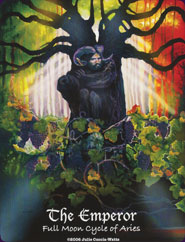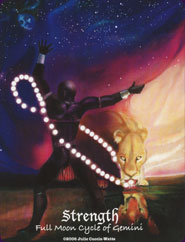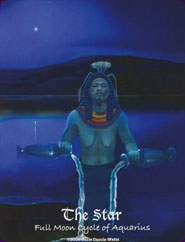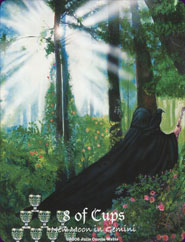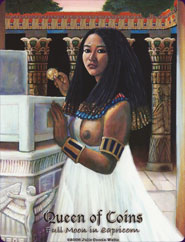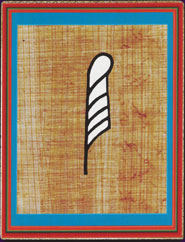Maat Tarot Deck Review
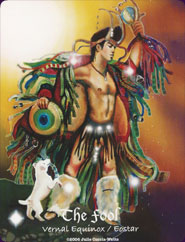
Creators: Julie Cuccia-Watts
Publisher: Self Published 2006
The Maat Tarot has 78 large-size cards rich in colour and symbolism, based on the lunar cycles and seasonal cross-quarters. The deck reinterprets and reorders the traditional deck to make a multicultural, deep and beautiful Tarot. Available as a deck only or with a hardback companion book.
Retailers
See Price at J. Cuccia-WattsMaat Tarot Review by James Ricklef
The MAAT Tarot, designed by Julie Cuccia-Watts, has an underlying structure largely based upon the lunar cycles through the zodiac. As a result of its emphasis on lunar phases, it provides an interesting shift in focus toward the power and importance of the feminine, but without ignoring or denigrating the Tarot’s masculine aspects along the way. Instead, this shift brings a fresh new balance to the Tarot.
For example, the Emperor in this deck is one of the most potent and vibrant versions of the card that I have seen. Its emphasis is less on the traditional aspects of rigidity and stagnation, which is depicted in many decks, and more on virility as well as a life affirming sense of mortality. As JCW says in the book that accompanies this deck, “... death is part of the healthy transitions of life.”
Another card for which I have gained more appreciation is the Judgment card. JCW associates it with Samhain (Halloween), which adds a wonderful dimension to it. Just as Samhain is the time when the veil between the two worlds (the worlds of the Living and of the Dead) is considered to be at its most tenuous, this card can indicate the quality of “Betwixt and Between” or a bridge between the material and the spiritual. It also can signify “Timelessness” i.e., that which is eternal and beyond the concepts and constraints of time (such as the soul). Additionally, it may indicate that you are being “haunted” by something from your past. These are all novel views of this card that now reside in my mental dictionary under the heading of “Judgment Card”.
There are many such delightful cards in this deck, but I do have to mention that there is one card that perplexed me and that I objected to initially. (It is the mark of a great deck, however, that there is only one such card in the MAAT Tarot.) I am referring to the Devil card. In an email correspondence, I asked JCW about this card. I found her comment that this card can represent "an intense and karmic relationship positive or negative. People we have to do work with" to be rather interesting. This explanation seems to work well with both the image and the sense of the Devil card.
She also noted that “this card is a fragment of the greater whole, a portion of a wheel of cause and effect, symbolized by the wheel of the year.” And since the Devil card is associated with the Winter Solstice in this deck, JCW also mentioned that "the Winter Solstice is the holiday or cross-quarter day that begins the return of longer days in the Northern Hemisphere, also known as the day when Mother Earth gives birth to the Sun child," which did explain the image on this card. However, I still felt a need to further reconcile this card’s image with traditional meanings associated with the Devil card, so I continued to delve into it on my own. What follows are some of my observations. In this card, we see a woman who is all alone as she gives birth. Although this is a difficult image, it is not the picture per se that I have a hard time with, but rather its assignment to a card called the Devil, so I considered some of this image’s nuances.
First of all, it can represent someone going through a frightening experience. There is a great deal of pain here, but this is something that the woman in this illustration has to go through in order to attain her goal. Also, this pain is something she must endure, just as we must all confront our own darkness (i.e., our own demons) in order to come to the light. Additionally, being the Devil card, I find the image on this card to be reminiscent of "Rosemary's Baby," so it can represent something that should be wonderful that has gone terribly wrong with horrible consequences instead. (Of course, one need not invoke a horror movie to make this point, since even today labor is not without its risks.) Finally, I decided to do a reading with this deck to see what insights I might gain into this particular card. The following is the spread that I used and the cards dealt:
1. How might I interpret this Devil card in a reading? Four of Wands
2. How can I reconcile its image with my basic view of a Devil card? Two of Cups
3. What can I learn from this version of the Devil card? King of Cups
To me, the scene on the first card, the Four of Wands, suggests isolation, and the resulting loneliness and solitude can create mental monsters, especially when we are in pain. Thus, this card may indicate the demons in our lives that we ourselves give birth to. Also, JCW notes that her Four of Wands indicates a “time for a new beginning,” and I can see that her Devil card may indicate a need to find a new perspective of our painful experiences. We should try to see beyond our suffering and not let it overwhelm us since every painful situation has the potential to bring some incredible new thing into our lives. Or, as an old saying goes, “when you're going through hell, keep going!”
Next, the snippet of a scene from a wedding that we see on the Two of Cups implies high hopes and good intentions. Applying this to the Devil card, we may interpret it to mean that despite our best intentions, we sometimes find ourselves wandering into our own private hell. Or, to quote another old saying, “the road to hell is paved with good intentions.”
Also, in light of the fact that the Two of Cups “represents unions of all types,” I looked for a union of the meanings noted previously with the traditional meanings I associate with this card. I often see in the Devil card indications of things like materialism and addictions, but perhaps I have divorced my understanding of the Devil card from some concepts of Hell that would be valuable here. It is important to remember that Hell can be a state of mind that we create for ourselves, often through our pain and the nasty perspectives born of our pain. Similarly, the Devil card may refer to the demons inside us, and in the MAAT Devil card I can see that it is through creating and nurturing those demons that we create our own private hell. (Again, is that Rosemary’s baby being born on this card?) In addition, perhaps I need to incorporate some of the Devil card’s more positive aspects, as we shall see as we consider the next card in this spread.
For the King of Cups, let me first note some of JCW’s suggestions about its interpretation:
“Food for the soul... This card represents a man who ... is calm, charming, and sweet... Despite the fact [that] he loves to party and wouldn't think of passing up a good time, this man is a 'keeper'.”
Perhaps instead of worrying about how to fit the image on this Devil card to my preexisting concepts about the card, I can learn more about the Devil card in general in light of these comments about the King of Cups. For example, should I consider the beauty of the Devil card, looking beyond the traditional Judeo-Christian connotations of its name? There is a more benign side of the Devil card that some people prefer, which can be summed up with JCW’s comment about her King of Cups: “he loves to party and wouldn't think of passing up a good time.” In other words, some people think of the Devil as the “party-hearty” card. However, we must remember that after the party, you may have to “pay the piper” (so to speak). As JCW notes in the MAAT book, “This card represents the results of lust greed and other human shortcomings.”
On the other hand, the hells that we go through are indeed “food for the soul.” We must pass through them in order ultimately to reach the light. For example, considering Scrooge’s journey of awakening in A Christmas Carol, we see that experiencing miserliness can (once we get past it) lead us to know true generosity.
On a more general note about this deck, I am impressed with JCW’s incredible sense of color, style, and composition, and I find that her deck has great value for its artistic merits as well as its worth as a divinatory tool. Also, while initially exploring the MAAT Tarot I was also doing research for a deck of my own, and so by coincidence I stumbled upon the realization that many of the MAAT Tarot illustrations are based (to varying degrees) upon old paintings. For example, the Prince of Swords obviously was inspired by Caravaggio’s The Martyrdom of St. Matthew and the 5 of Swords recreates his painting, The Cardsharps. In an email, I asked JCW about this, and she provided the following explanation:
“Not all images in the MAAT Tarot are based on master paintings but many do have bits and pieces of master paintings in them. The Masterpieces that have been used have been altered in subtle ways to serve the purpose of illustrating the symbolic requirements of the individual card.”
Perhaps as a result of this diversity of inspiration, there is a wide assortment of subjects and cultures represented in these cards, such as American colonial (see, for example, the Five of Wands), Native American (Seven of Wands), Medieval (Four of Cups), Mythical (Eight of Cups), and Ancient Egyptian (Justice). Fortunately, JCW’s strong artistic vision shines through them all and unifies what, in the hands of a lesser artist, could have been a confusing jumble of themes. Instead, she has woven these disparate threads into a rich and alluring tapestry that engages and inspires us with its depth and complexity of meaning.
The following are some miscellaneous technical remarks about this deck:
* There are no borders on the cards (i.e., the images bleed to the edges).
* The Major Arcana cards are unnumbered. (This does not bother me, but I know that some people seem to need to have those numbers appearing on these cards.)
* The court cards are named Princess, Prince, Queen, and King.
* The suits are named Coins, Swords, Cups, and Wands.
* There are several title changes in the Major Arcana. For example, The Hanged Man is renamed The Hanged One, and the Hierophant is called The High Priest. These modifications of nomenclature are quite minor, and I rather like them. I just wish that the Devil had been renamed too, perhaps to “Hell.”
* JCW attributes the element of Air to Wands and Fire to Swords. Although most Tarot decks have been based on the elemental associations of Wands = Fire and Swords = Air, there are some that reverse that correspondence, and the MAAT Tarot has. If you are used to the more typical association (as am I), this may present a bit of a challenge at first -- at least for a few of the cards. However, I have found that the cards in this deck still make sense on their own merit, although you might want to ignore or reinterpret the meanings provided for the Wands and Swords cards in the accompanying book as a result. But then, I always use a deck’s book meanings as suggestions, not mandates, anyway.
And speaking of which, I would like to conclude with a few comments about the book that comes with this deck. There
is a very friendly feel to it, as if we are having an intimate chat with the author. For example, JCW scatters wonderful
tidbits of knowledge about myths, history, etc. throughout this book. These little edifying treats are obviously intended
to enrich the reader's understanding of the cards, but they are also interesting and informative on their own merits.
More important, though, are this book’s explanations of the cards themselves. Some of the cards in this deck are
similar to the traditional Waite-Smith versions, but others involve some radical departures for which I found myself
wanting some clarification. Fortunately, the accompanying book came through admirably, providing excellent
explanations that illuminated the cards’ meanings and even revealed new insights into the Tarot in general along the
way.
Maat Tarot Review by Kate Hill
The Maat Tarot is the third tarot deck from Julie Cuccia-Watts, and is a full deck of 78 large and vibrant intuitive paintings based on the lunar phases and seasonal cycles.
Julie Cuccia-Watts is perhaps best known for the Ancestral Path Tarot, published in 1990, and the later 22-card art deck, the Blue Moon Tarot. The Maat Tarot evolved from the ideas of the calendar in the Blue Moon Tarot and the weeks of the year in the Ancestral Path Tarot, to link with the cyclical patterns of the natural world. Unlike a typical linearly-organised tarot deck, these cards are ordered to correspond with lunar cycles, seasonal festivals, and zodiac associations. Thirteen majors relate to the thirteen full moons, eight majors to the cross-quarter days in the Celtic calendar, and the remaining card, the World, is the central card in the cycle. The Aces are linked with the seasons, and the rest of the minor cards, rather than being connected with the 52 weeks of the year, and connecting with the lunar phases. (The book has a pictorial diagram that illustrates the placement of each card in the complex pattern.)
The word ‘Maat’ was chosen for its translation as justice or truth, and because the goddess Maat was the wife of Thoth, the Egyptian god of magic, which suited the female-centred world view of the cards. The name might imply Egyptian-style Tarot imagery on the cards as well, but the deck draws on many cultures, spiritualities and time periods through world history as well as ancient Egyptian - 18th and 19th century Europe, Native American cultures, and some more abstract or timeless paintings.
The cards and characters inhabit the natural world, and on the whole are colourful, vibrant and full of life. Some imagery is a little confronting because of its female physicality, with the Devil card the most so: a woman with long, dark hair, is naked and giving birth, the baby’s head just visible and light streaming through. It’s an interesting interpretation of the Devil – certainly an image of sensuality, of earthly power, and utter control to a bodily or lower plane force. The Magician is similar, and appears to be the same dark-haired woman as in the Devil, still naked, bending down to a baby held in both her hands. A few cards also appeared in the Blue Moon Tarot and have been used again here: the Moon, and the World.
Each card has its painted image filling the card to the edge – there are no distracting borders here. Printed on the card are the title, lunar position, seasonal holiday or astrological position, and the artist’s copyright message. The backs of the cards have an Egyptian feel, with papyrus-like background, a hieroglyph in the center, and an outer border in bright blue, red and black. In the hand, the cards are very glossy with laminate, shiny, and slick, but not so much that the stack of cards slides off the table.
The Maat Tarot has been self-published as a rather beautiful limited edition of 1000 copies. The 78 large-size cards come with a lovely hardback companion book, made with creamy textured paper and set in an old fashioned looking typeface (that is initially a little hard to read but it suits the deck and its theme). The book is decoratively laid-out, with decorative elements, illustrations and borders at the beginnings of chapters, plus black and white images of the cards.
The cards could be used without reference to the book if desired, but they are really an integral part of the system. The book follows the unusual ordering (it can take a while to find the cards you’ve drawn in a reading to begin with), and begins by dividing them into four parts, corresponding to the seasons and the Aces. Each part is divided into chapters, each linked with a major arcana card, and then five to six other cards are associated with that cycle. For example:
Part 1 – Swords (Ace of Swords – Autumn/Fire
Chapter 1 – Full Moon Cycle of Aries – The Emperor
The Tower / Prince of Swords / 2 of Swords / 3 of Swords / King of Swords / 4 of Swords
The book also follows Julie’s journey through Tarot, the process of creating the Blue Moon Tarot and then expanding and building on that to make the Maat Tarot. Julie explores each of the 78 tarot cards through myth and legend, also giving the traditional tarot meaning and what that Maat Tarot card might represent in a reading.
The Maat Tarot is definitely not a traditional deck, but is instead a unique interpretation of tarot though natural cycles – lunar, solar, earth and physical – and Julie’s intuitive paintings. Along with its companion book, it’s a high quality set that I’d recommend for meditation and tarot work, for intuitive readings – or just for the joy of having it in the collection.
Complete Details of Maat Tarot
Creators: Julie Cuccia-WattsPublisher: Self Published 2006
Deck Type: Tarot Deck
Cards: 78
Major Arcana: 22
Minor Arcana: 56
Deck Tradition: Unique
Minor Arcana Style: Unique Scenes With Suit Symbols
Suits: Cups, Swords, Wands, Coins
Court Cards: Princess, Prince, Queen, King
The Fool is Unnumbered
Strength is Unnumbered
Justice is Unnumbered
Card Size: 4.25 x 5.75 in. = 10.79cm x 14.61cm
Card Language: English
Card Back: Non-reversible
Back Design: Papyrus textured background, black and white papyrus hieroglyphic in the center, blue and orange outer borders.
Companion Material: Beautiful hardback companion book by Julie Cuccia-Watts.
Rating: 18/20 or
Similar Decks to Maat Tarot
Theme: Astrology, MulticulturalCategory: Borderless Tarot Decks
Creator: Ancestral Path Tarot, Blue Moon Tarot, Journey into Egypt Tarot by Julie Cuccia-Watts
< Previous Deck · Back to Top · Next Deck >
Home > Tarot Reviews > Maat Tarot Review

